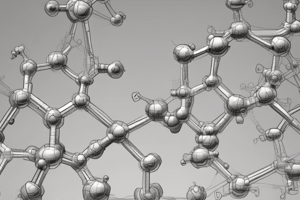Podcast
Questions and Answers
What methods can be used for the preparation of alkanes?
What methods can be used for the preparation of alkanes?
- Dehydrohalogenation
- Oxidation reactions
- Catalytic hydrogenation (correct)
- Steam reforming
Which type of reaction is primarily involved in the halogenation of alkanes?
Which type of reaction is primarily involved in the halogenation of alkanes?
- Nucleophilic substitution
- Esterification
- Free radical substitution (correct)
- Electrophilic addition
What theoretical framework helps explain the stability of cycloalkanes?
What theoretical framework helps explain the stability of cycloalkanes?
- Valence bond theory
- Pauli exclusion principle
- Baeyer’s strain theory (correct)
- Molecular orbital theory
Which theory is associated with understanding strainless rings in cycloalkanes?
Which theory is associated with understanding strainless rings in cycloalkanes?
Which of the following statements best describes the reactivity of alkanes in free radical reactions?
Which of the following statements best describes the reactivity of alkanes in free radical reactions?
What is the general formula for alkanes?
What is the general formula for alkanes?
Which of the following statements about the physical properties of alkanes is true?
Which of the following statements about the physical properties of alkanes is true?
Which of the following reactions do alkanes typically undergo?
Which of the following reactions do alkanes typically undergo?
What impact do alkanes have when burned?
What impact do alkanes have when burned?
What characteristic allows alkanes to exhibit isomerism?
What characteristic allows alkanes to exhibit isomerism?
Study Notes
Alkanes
- Alkanes with up to 5 carbons are the simplest saturated hydrocarbons.
- They can be prepared by catalytic hydrogenation, which involves reacting a compound with hydrogen gas in the presence of a catalyst.
- Another method of preparation involves reacting Grignard reagents with an appropriate electrophile.
- Alkanes undergo free radical substitution reactions, the most well-known being halogenation, where a halogen atom replaces a hydrogen atom.
- Halogenation reactions exhibit selectivity and reactivity, meaning certain hydrogen atoms are more likely to be replaced than others.
- Understanding the mechanisms behind these reactions helps in predicting selectivity and reactivity.
Cycloalkanes
- Cycloalkanes are cyclic alkanes with carbon atoms arranged in a ring.
- Baeyer's strain theory explains the relative stabilities of cycloalkanes based on the deviation of bond angles from the ideal tetrahedral angle (109.5 degrees).
- According to Baeyer, cycloalkanes with smaller rings experience angle strain, which makes them less stable.
- Sache–Mohr theory builds on this, considering that cycloalkanes can adopt different conformations to minimize strain.
- The theory states that "strainless" rings minimize strain by adopting favorable conformations.
Alkanes: Exploring the Basics
- Definition: Saturated hydrocarbons with the general formula CₙH₂ₙ₊₂. They only contain carbon (C) and hydrogen (H) atoms.
- Characteristics:
- Non-polar molecules, making them insoluble in water but soluble in non-polar solvents.
- Exist in straight-chain (normal) or branched forms.
- Simplest Alkanes: Methane (CH₄), Ethane (C₂H₆), Propane (C₃H₈).
- Bonding: Exhibit single carbon-carbon bonds (sigma bonds), contributing to their stability.
- Physical Properties:
- Typically colorless and odorless.
- Exist as gases or liquids, with boiling and melting points increasing with molecular size due to stronger van der Waals forces.
- Less dense than water.
- Key Reactions:
- Combustion: React readily with oxygen to produce carbon dioxide (CO₂) and water (H₂O).
- Halogenation: React with halogens (e.g., chlorine, bromine) in the presence of UV light, producing halogenated alkanes.
- Isomerism: Can exhibit structural isomerism due to different arrangements of carbon atoms. The number of possible isomers increases with the number of carbon atoms.
- Sources and Uses:
- Found naturally in petroleum and natural gas.
- Used as fuels (e.g., methane for heating), and in producing lubricants, waxes, and various chemicals.
- Environmental and Health Concerns:
- Combustion contributes to air pollution.
- Certain halogenated derivatives can be toxic and pose environmental hazards.
Important Alkanes
- Methane (CH₄): Primary component of natural gas.
- Ethane (C₂H₆): Common in natural gas and used in ethylene production.
- Propane (C₃H₈): Used as fuel for heating and cooking.
- Butane (C₄H₁₀): Found in lighters and used as fuel.
Safety Considerations
- Highly Flammable - Proper storage and handling are crucial.
- Leak Detection & Ventilation: Essential where alkanes are used.
Studying That Suits You
Use AI to generate personalized quizzes and flashcards to suit your learning preferences.
Description
This quiz covers the fundamental concepts of alkanes and cycloalkanes, including their preparation, reactions, and stability theories. Dive into topics such as catalytic hydrogenation, free radical substitutions, and Baeyer's strain theory. Perfect for students studying organic chemistry.



